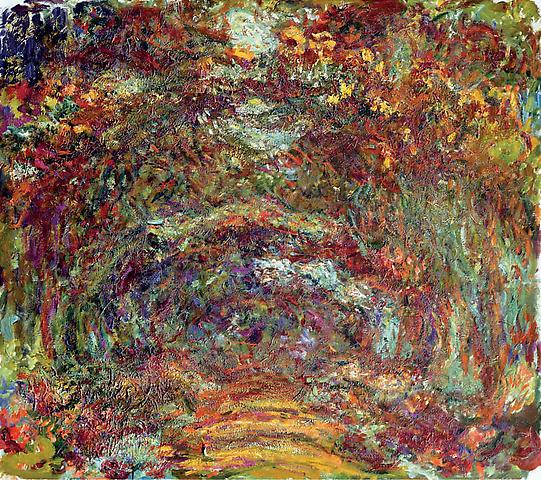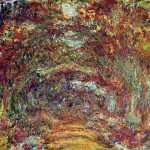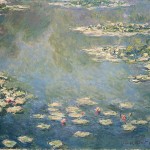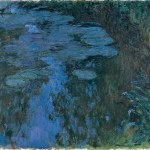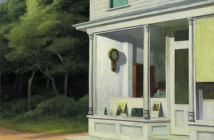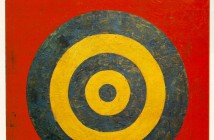What could be left to say about Claude Monet? The iconic Impressionist has been the subject of major shows dotting the globe for each of the past ten-plus years, many times simultaneously. There are notepads, calendars, screensavers, action figures and lunchboxes that attest to the recognition and attention the artist continues to receive. If anything, one would expect an awkward silence at this point in the conversation, not a stirring testimonial.
Enter Paul Hayes Tucker and the Gagosian gallery. While much has already been said around Late Work, and other recent commercial shows, as to the importance of gallery exhibitions in advancing art at this moment—when museums seem dominated by other concerns—this coupling of the curatorial skills of Tucker with the reach and dominance of Gagosian has produced a Monet exhibition that is nothing short of marvelous. From the spare walls that call back to the artist's private explorations in his studio at Giverny, to grouping these masterful lilies that haven't been shown together in some cases since 1909, to a revealing, insightful and beautiful catalogue, and there are countless reasons why the show is moving and important; a declaration of the importance, vitality, and painting dominance of Claude Monet.
The exhibition takes great care to show the public and private sides of the artist as he wrestled to perfect the relationships between things, and perhaps his place in history. In these late works he makes major leaps of innovation and shifts the orientation of canvases from horizontal to vertical to create portraits of lilies—mirrors to the viewer—rather than placid landscapes. Monet also increasingly focuses the attention down, down, down so that the surface of the water in these paintings becomes the surface of the canvas, and the contrast between expressionistic circles and swatches of paint is intense against the flower buds that burst from canvas skin. These surfaces play against the triple-reality that is presented here: reflected sky, surface, and water beneath. In shifts and reflections the later Monet's invite us in and keep us out, as with the public and private sides of the man himself. They are evidence of an artistic pursuit that is far beyond the perfection of rendering. Rather, as Monet decided to depict these lilies in extreme focus, he disregards the conventions of painting and creates his own rules along the way.
It may be hard as a 21st Century audience to appreciate the daring required to tip attention down to the pond, and render a horizon-less world in vertical canvases that have dabs and swoops of paint to suggest objects, but the challenges Monet created and the results he achieved are no less than incredible—and are evident here. While we are an audience now schooled by the arc of 20thCentury art, these works are durable and important and rattle from the walls.
Impression/Post-Impression: Modern/Postmodern
The lilies at Gagosian provide rich evidence that Monet was not only the master of the modern, but also a pathfinder in the postmodern, and essential to cubism, collage, abstract expressionism, and the like. In many ways the layered experience of these lilies, where Monet displays the surface of the water, the roots below, and the sky reflected overhead simultaneously, are prophesies to the layered experience of contemporary 21st Century life. Certainly he was pivotal in creating art that democratized subject matter and personalized experience with his Impressionist masterpieces, but as Late Work at Gagosian attests, in his later years Monet was relentless in his experimentation and courage. He plunged new depths and went beyond the use of color, form, line, and composition that even his successors in the Post-Impressionist period had accomplished.
Take Cézanne for instance, whose insistence at maintaining a balance between technique and experience have famously left blank spots on canvas where the artist felt he couldn't discern where one thing began and the other ended. Relentless in his pursuit of understanding optics and challenging the conventions of painting—classical techniques of foreshortening, perspective and scale for instance—Cézanne abandoned the literal tricks of the trade and focused on looking. The results are torqued still-lifes, flattened landscapes, and an entirely personal and intimate method of expression. Similarly, Monet in these later efforts, abandoned the traditions of painting. His decision to tip the focus of the works down into the pond—abandoning horizon entirely—is one that necessitated devising new ways to render objects and produce spatial effects. The results, as evidenced in the Gagosian show, are abstract, disorienting, expressive, simple, complicated, meditative, and filled with innovation and wonder. Curator Paul Hayes Tucker and Monet make a case on these walls that the super-Impressionist has trumped van Gogh, Cezanne and Gauguin as the last word. In a moment when Monet had the means and reputation to glide prosperously into immortality, this exhibition reveals a man ever-advancing the craft of painting and engaged in heavy competition with both his peers and his mortality.
The arguments have already been made, as early on as 1956 by Clement Greenberg in his essay "The Later Monet," that the Impressionist master was the precursor to the Abstract Expressionist movement. However, while Greenberg paralleled Monet and Pollock in his writing, the Gagosian show moves far beyond. For instance, the light source made with oils somewhere there just behind the surface of the canvas in these works creates intense connections between Monet and Rothko. Here there are comparisons between the twisting body of light whose sinewy figure dances between the lilies of Monet, to an El Greco Christ—an iconic shape that is repeated over and over again in these later works Rothko's reliance on the lozenge-like shimmering squares. Monet is on display here as a master of Impressionism and a prophet of the coming tide. These works also suggest Rothko's in their approach, as Monet would leech the oil from his paints to reduce them to more physical form, just as Rothko actually applied the powder from pigments to achieve his glowing light. With the art elite of NYC and beyond wandering into Gagosian Chelsea it is easy to see how much there is left to learn from the legacy of Claude Monet.
Indeed, in terms of the shift from the modern to the postmodern, it is important to recognize that the works in the first room of the exhibition represent paint application that was likely the most abstract ever seen in 1909, when they were first displayed. True abstraction as we perceive it now—as with Picasso or Kandinsky—had yet to be shown and is generally dated sometime near 1910. While we associate Monet and the Impressionists as rendering the modern with the emerging middle class, the intersection of culture and technology, new fashions, and suburban sprawl, the paintings here, from the artist's 20th Century efforts, go much farther and work to depict the complexities of the postmodern. Thus, in many respects the show underscores the fact that Monet was not simply the icon of Impressionism, and the modern, but actually the leading master of postmodernism.
Beyond his daring depiction of the surface/sky/depths in the lilies shown here, Monet made a great number of experiments with the orientation of canvases and the relationships of lilies to the space and reflection in these works. In fact, this too is a two-fold revelation of the show—watching Monet play with the same shapes and sizes and altering color and line within these confines to shimmering light effects. Further, changing the orientation of the lilies in the 20th Century from horizontal to vertical indicates a shift in the story. This was an unprecedented move in a landscape painter's tool box. The vertical orientation was significant as this device historically—and almost subconsciously—indicated the painting of a portrait rather than a landscape or a narrative. Coupled with the reflective surface of the water itself, and tipping the perspective of these works down to mimic the surface of the canvas with the surface of the water, and Monet created an allegory for staring at ourselves in the mirror.
These works were so striking and peculiar to the early-20th Century eye that Monet's dealer Durand-Ruel was hesitant to show them. Here are the beginnings of abstraction—and the postmodern rendering of experience—as Monet had progressed from the man rendering light and shadows in symphonic delight, to an artist showing the layered nature of experience, the intricacies of looking, the surface of canvas as the surface of water, and the light itself emanating from behind the surface of the canvas.
This light from inside the canvas itself, rather than landing or originating elsewhere has essential importance for the approach in 20th Century art. As with the above, Rothko at his simplest was a genius for using pigment to render light. One of my most intense relationships to art occurred at the Whitney retrospective of Rothko's work where the pulsing, shimmering, physical light was so intense from the enormous canvases that it seemed certain there were light bulbs connected behind the canvases emitting light and filtered through the painter's colors. The foundations for this approach—this rendering light as a palpable something that originates from behind the surface of the canvas—is apparent here in Monet's later work. Take for example the sunset reflected between the lilies seen in Nymphéas from 1907 on loan from the Musée Marmottan Monet in Paris— the space between these shapes is a twisting, sensual body on the surface of the water that reflects purple-magenta-red. But as the orientation of the work has left horizon behind, the light here originates from behind the canvas. So, while many associate Monet with his ability to create a physical light that lands on haystacks, bridges, poppy fields and parasols, the light here glows from within. And as with Rothko, this light emitting from inside ourselves—as we look at ourselves in reflection—is the very essence of a spiritual journey.
Interesting that beyond the first room of Late Work the lilies are warped and torqued, suggesting a struggle and energy. He is clearly continually adjusting the relationships of surface to depths—of one lily pad to he next—and the surfaces sweep and swoop. Lilies become expressionist circles suggested with the forms of flowers solid and still and popping from the canvas surface. With the light and spiritual references, one can see these lilies as a postmodern set of contemporary halos glowing in ecstatic annunciation. Just as the shift from Renaissance masters moved from rendering halos as flat circles—plate like and still behind the various heads of saints—to a glowing light source—these Monet lilies twist and shoot light from within—beyond. Indeed, Monet was captivated by the past masters of Renaissance and the comparison to the pieta in the El Greco, a twisting Christ-like light, is hard to ignore. Quite literally the artist is rendering The Light, the body of light, and Monet used these late lilies as a vehicle for self-exploration, artistic innovation, and personal discovery.
The revelation of the man himself and his inventiveness is as paramount to these paintings as the lilies are—and this shift in focus from rendering subject to observer is a dramatic shift as well. This is the precursor to contemporary expression. Up until this moment Monet retained a reverence for his subjects. Certainly they were romanticized and altered, imbued with personal emotion or "impression" but these later works become the groundwork for something altogether different, as Greenberg noted. Watching the emotions float on the surface of these canvases seems so similar to the process of the Abstract Expressionist. It is not the question of applying paint randomly, subconsciously, or haphazardly that is the connection in these works, but the attempt to render the spiritual, the emotional, the impossible to define, yet infinite and enduring qualities of existence, that these paintings lead the way to. It is interesting how dark some of these later works become, also like Rothko or Clyfford Still. The show ends on a punctuation mark of a mass of deep blues—nearly black—and a cast against of weeping willow against the water. Could this be an older man facing the inevitable end to darkness, or an embrace of the beauty and vastness of the infinite? Unlike Rothko, whose dark Houston chapel paintings seem to suggest despair, there is a quiet celebration in these Monet's: a triumph.
It's worth noting that with his curatorial efforts, such as Monet in the 20th Century, Monet in the 90's, numerous books and lectures, Paul Hayes Tucker has arguably done as much to advance the case for the power of these paintings and their importance as any. While many of these pictures were once considered uninteresting and stale, under-appreciated and homeless in the studio of Monet through the 1950's, Greenberg and the Abstract Expressionists helped reintroduce the world to the artist. However, Tucker has repeatedly allowed us all to recognize the significance, importance, and glory of these later works, and seems to advance the conversation deeper and deeper every step of the way. Once a set of cute footnotes to a wonderful career, these late works are now the most sought after and significant thanks, in part, to his continued curatorial care and academic efforts. How much so? While I am hesitant to ever concede the timeless qualities of any paintings, the deft line work, color, shape and perspective in these pictures stand firm against any in the history of art. The case is made so completely in Late Work, Monet emerges as the painter of the 20th Century with this Gagosian show. The expressive circles played against bursting blossoms shift from lilies to haloes to crowns here—as Monet's technique and skill, arrival and permanence, sound the music of regal horns in NYC this June. This show is coronation for a king.
- Claude Monet, L’Allée de Rosiers, Oil on canvas, 1920-1922
- Claude Monet, Nymphéas, Oil on canvas, 1906
- Claude Monet, Nymphéas, Oil on canvas, 1914-1917
"Claude Monet: Late Work" is on view May 1 – June 26, 2010 at Gagosian Gallery.
All images are courtesy of the Gagosian Gallery website.

